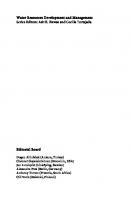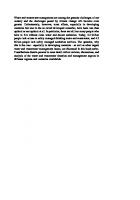Transparent Water Management Theory: Sefficiency in Sequity 9811562830, 9789811562839
This book provides a solid foundation for a comprehensive, systemic and water-centric approach to water management. Said
198 8 5MB
English Pages 136 [126] Year 2020
Table of contents :
Preface
Acknowledgements
Contents
Abbreviations and Symbols
1 Introduction
1.1 Water Security, Governance or Management
1.2 Bounded Rationality
References
2 Terminology
2.1 Water Use System (WUS)
2.2 Pillars: Quantity, Quality, Benefits
2.3 Water Use and Reuse
2.4 Binary Opposites in Water
2.5 Water Loss of Flows and Systems
2.5.1 Unrecoverables
References
3 Theory
3.1 Five FIWs (Foundational Ideas About WUS)
3.2 Learning with Stakeholders
3.3 Smart Water Use Systems
References
4 Sefficiency (Sustainable Efficiency)
4.1 Proof of Sefficiency Indicators
4.2 Levels of Management
4.3 Weights
4.3.1 Quality Attribute
4.3.2 Beneficial Attribute
4.3.3 Usefulness Criterion
4.4 Trade-Offs
4.4.1 Jevons Paradox
4.4.2 Three Impacts in Differentials
4.4.3 Patterns
4.5 Alternatives
4.5.1 Classical Efficiency
4.5.2 Water Productivity
4.5.3 Effective Efficiency
4.5.4 Resiliency
References
5 Sequity (Sustainable Equity)
5.1 Categories
5.2 Segments
5.3 Equity Revisited
5.3.1 Equality
5.3.2 Conservation
5.3.3 Sefficiency
5.4 Targets
5.5 Four Policy Types
5.6 Reality Check
5.7 Phases in Decision-Making
References
6 Applications
6.1 Water Saving Myth
6.2 Urban
6.3 Equity
6.4 Farm
6.5 Water, Energy, Food
6.6 River, Urban, Farm
6.7 Trade and Water Footprint
References
Appendix A Equivalency
Appendix B Sefficiency Template
Appendix C Environment and Social Contract
Index
Preface
Acknowledgements
Contents
Abbreviations and Symbols
1 Introduction
1.1 Water Security, Governance or Management
1.2 Bounded Rationality
References
2 Terminology
2.1 Water Use System (WUS)
2.2 Pillars: Quantity, Quality, Benefits
2.3 Water Use and Reuse
2.4 Binary Opposites in Water
2.5 Water Loss of Flows and Systems
2.5.1 Unrecoverables
References
3 Theory
3.1 Five FIWs (Foundational Ideas About WUS)
3.2 Learning with Stakeholders
3.3 Smart Water Use Systems
References
4 Sefficiency (Sustainable Efficiency)
4.1 Proof of Sefficiency Indicators
4.2 Levels of Management
4.3 Weights
4.3.1 Quality Attribute
4.3.2 Beneficial Attribute
4.3.3 Usefulness Criterion
4.4 Trade-Offs
4.4.1 Jevons Paradox
4.4.2 Three Impacts in Differentials
4.4.3 Patterns
4.5 Alternatives
4.5.1 Classical Efficiency
4.5.2 Water Productivity
4.5.3 Effective Efficiency
4.5.4 Resiliency
References
5 Sequity (Sustainable Equity)
5.1 Categories
5.2 Segments
5.3 Equity Revisited
5.3.1 Equality
5.3.2 Conservation
5.3.3 Sefficiency
5.4 Targets
5.5 Four Policy Types
5.6 Reality Check
5.7 Phases in Decision-Making
References
6 Applications
6.1 Water Saving Myth
6.2 Urban
6.3 Equity
6.4 Farm
6.5 Water, Energy, Food
6.6 River, Urban, Farm
6.7 Trade and Water Footprint
References
Appendix A Equivalency
Appendix B Sefficiency Template
Appendix C Environment and Social Contract
Index

- Author / Uploaded
- Naim Haie
![Transparent Water Management Theory: Sefficiency in Sequity [1st ed.]
9789811562839, 9789811562846](https://ebin.pub/img/200x200/transparent-water-management-theory-sefficiency-in-sequity-1st-ed-9789811562839-9789811562846.jpg)







![Water Management In 2020 And Beyond [1 ed.]
1865134835](https://ebin.pub/img/200x200/water-management-in-2020-and-beyond-1nbsped-1865134835.jpg)
